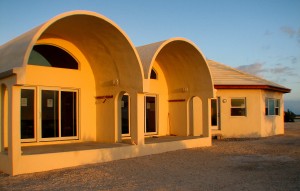When looking at the myriad components defining a sustainable home, operational efficiencies become key in realizing high performance building systems, which will minimize carbon footprint and cost of energy factors.
A zero energy building (ZEB) or net zero energy building is a general term applied to a building’s use with zero net energy consumption and zero carbon emissions annually. See Zero Energy Building on Wikipedia.
Two significant design factors for ZEB’s:
- Reduction of energy demand for a specific design.
- Supply the lowest impact/carbon neutral energy to the project.
The thought process regarding designs for ZEB’s evolve along the following lines:
- Need
- Location
- Passive Options
- Assisted Options
- Mechanicals
- Interactive Options (smart controls)
- Commissioning (multi-year process)
- Improvements (through logging home data and learning from this)
- Purchase Offsets (carbon) or implement renewable energy on site
Active Systems vs. Passive Designs:
Passive Solar heating design includes increasing temperature thresholds by 1 degree hotter and colder and a focus on night-time cooling options (assisted, if needed) with daylight harvesting tied in with smart controls for both heating and lighting. Solar chimneys may be incorporated in order to avoid the addition of mechanical cooling systems. Occupants will be linked closely with these passive systems in terms of heating and cooling (modifying existing behaviors), including the use of electricity (plug loads, etc.).
Some Systems that Apply:
Heat exchangers have become a design requirement in airtight buildings. These may take the form of HRV’s (north) ERV’s (south) and GFX thermal recovery systems for downpipes (hot water energy recovery).
Ground or water source heat pumps connected with hydronic heating systems may provide winter heating if site conditions allow (typically grid-tied only). Motors with ECM specifications should be utilized. See Brushless DC Electric Motor on Wikipedia.
LED lighting systems will allow substantial savings on energy and provide extremely durable service life. See Light Emitting Diode on Wikipedia.
Renewable Energy:
Renewable Energy may be utilized in off-grid or grid intertie applications. Solar Thermal systems should be incorporated into the design before Photovoltaic’s (PV), as payback is almost always superior. Wind energy in a hybrid system may be considered if site factors allow. Back-up generation will be required for all off-grid systems to augment battery power if the renewables fail. See Renewable Energy on Wikipedia.

Photo courtesy of ceibahamas.org
The purchase of carbon credits for energy and transportation of materials should be considered. Note that purchasing offsets or applying renewable energy is last on the list. Efficiencies in design, materials and passive/assisted systems are more highly weighted and important in a sustainable home than purchasing a large renewable energy system to make up for design/material inefficiencies.
Rating Systems:
There are currently a developing number of rating tools and systems on the market designed to help model and measure the performance a Net Zero home. They apply current and new best practices to ensure the building performance meets expectations, when newly commissioned and in years to come.
Models include:
PassivHaus
Building America Prototype
More models and rating tools are becoming available, worldwide, a trend that points to the growing acceptance of high performance buildings and a renewed demand by homeowners to make their homes a more comfortable, healthier and carbon neutral place to live.